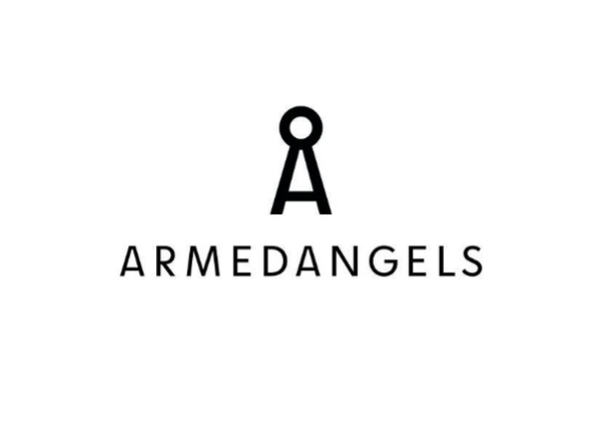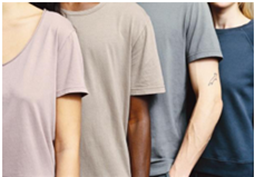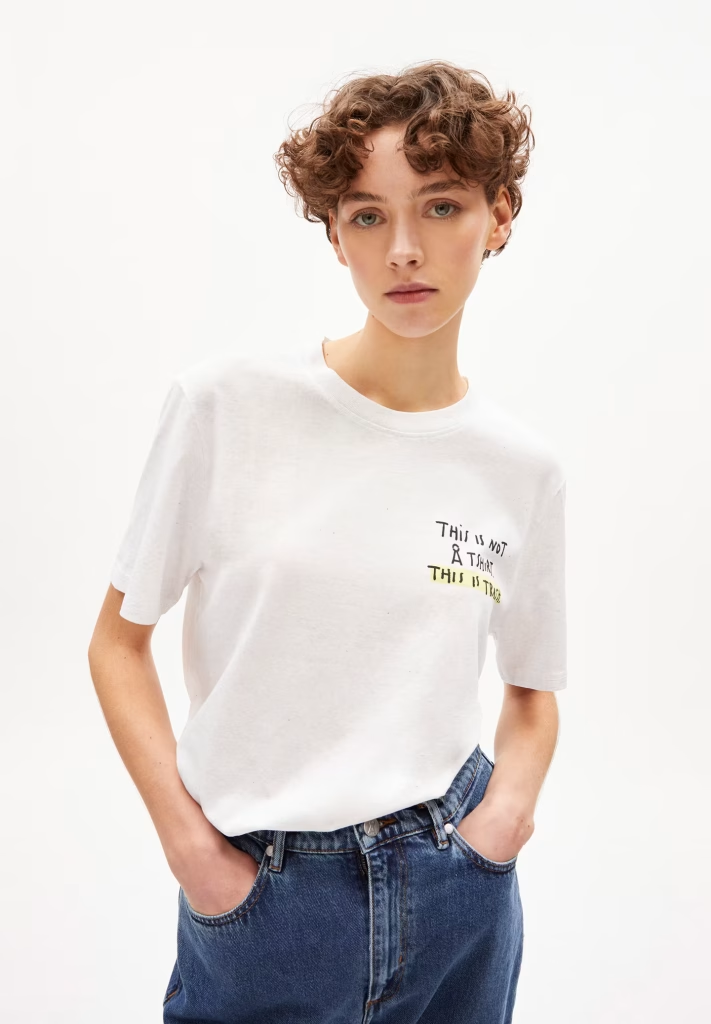Design Thinking at Armedangels – Sustainable Fashion Reimagined
The vision of Armedangels

Armedangels was founded in 2007 with a clear vision: fashion should become more sustainable. The founders, Martin Höfeler and Anton Jurina, met in cologne while studying business administration and wanted to create an alternative to the fast fashion industry, which is often linked to poor working conditions, pollution, and resource waste. To be precise, this wasn’t the first idea. But after the company was founded with the goal of producing fair trade T-shirts so that a portion of the profits could be donated, it quickly evolved into something bigger. Their approach went then far beyond just using organic cotton or recycled fabrics – they focused on sustainability in all areas, from material selection to production and the circular economy. Armedangels also set the goal of combating climate change; they understand that only through collective efforts can radical change be achieved to keep the climate in balance. [1, 5]
Moving beyond greenwashing
But Armedangels went one step further, many fashion companies engage in greenwashing and use sustainability only as a marketing tool without implementing far-reaching changes. To clearly distinguish itself from this, Armedangels deleted all sustainability claims from its communication. Their statement: There are no sustainable products, as every production leaves an ecological footprint. Instead of making unrealistic promises, the company relies on clear and honest communication – without losing sight of its mission. [1]
This statement underlines the discrepancy between companies that use sustainability as a mere PR strategy and those that actually stand for change. Armedangels openly admits that it is not perfect, but it works tirelessly to revolutionize the fashion industry in the long term.
About the participants and Design Thinking
A crucial part of this change process is the centralized position of customer needs. Even though Armedangels did not explicitly follow the Design Thinking approach, their development journey aligns closely with its principles, which are studied in this course. The focus is on the customer because their expectations of sustainable fashion determine the strategic orientation. Designers and product developers work on new materials, cuts, and production methods, while suppliers and producers ensure that fair working conditions are observed, and environmentally friendly production methods are implemented. Technology partners like Paretos are helping to avoid overproduction with AI-powered demand forecasting, which helps both the environment and the company. Certification bodies such as GOTS or the Fair Wear Foundation ensure transparency and credible sustainability standards. This helps customers to gain even more trust in the company. [2, 4]
Understanding customer needs
The Design Thinking process at Armedangels takes place in several phases. The first phase, empathy, is dedicated to understanding customer needs. Many consumers want to buy eco-friendly clothing but are often unsure whether a product is truly sustainable. To close this transparency gap, Armedangels relies on a fully traceable supply chain and open communication. Part of that is their detailed website, where customers can follow the whole process of the production process and find information about all the achievements.
Defining the problem
In the subsequent problem definition phase, central challenges are identified. The fast fashion industry is characterized by poor working conditions, child labor, the use of environmentally harmful chemicals, and immense textile waste. There is also a discrepancy between customers’ desire for sustainable clothing and the reality of the fashion industry, which continues to focus on short-term trends. One key challenge Armedangels identified was that many consumers were willing to spend more on sustainable fashion but found the available options either too expensive or aesthetically unappealing. [2, 4]
Exploring ideas and alternative solutions
The next phase of Design Thinking, the ideation phase, is dedicated to the development of creative alternatives to fast fashion. Armedangels explored multiple approaches before arriving at their current solutions.

In the search for environmentally friendly dyeing methods, natural dyeing techniques were explored. The “Dyed by nature” series from 2020 was the result, which remains available today. This method reduces the use of harmful chemicals and minimizes the negative environmental impact, because it needs less energy and water. Every piece is also unique because natural colors can change over time. [3]
The “Preloved Portal,” which gives customers the opportunity to return their used Armedangels clothing, is another solution. The company offers two options for extending the life cycle of garments: resale and recycling. If a piece is still in good condition, it is resold through their Secondhand Shop, and the original owner receives a voucher for future purchases. If the clothing is too damaged for resale, it is responsibly recycled and transformed into new textiles through the “Trash to Fash” initiative. This system helps reduce waste and environmental impact while fostering a circular economy in fashion. [2, 4]

The company introduced a completely recyclable shirt, called Circular Tee, which combines these recycling pieces with the natural, renewable fiber Lyocell and thus achieves a circular product. [2, 4]
Speaking of waste reduction: You can book a repair service via the Armedangels website, which will then repair the broken garment, if possible, with spare parts. As a result, Armedangels offers a quick and easy solution that extends the life of the products even further. However, this service is subject to a fee – just like it would be at a regular tailor’s shop. But it also shows that Armedangels has recognized the needs of its customers and wants to offer clear and simple solutions across all areas. [2, 4]
In many cases, customer feedback played a crucial role in determining which ideas were pursued further. For example, consumer concerns about the longevity of biodegradable garments led Armedangels to favor circular solutions over purely compostable ones. Similarly, customer skepticism regarding clothing rental models contributed to their decision to abandon this approach. [2, 4]
Of course, new ideas are endless, but this blog post focused on the ones customers can find in the shop.
Prototyping and testing sustainable innovations
In the prototyping phase, Armedangels actively explores and tests innovative production methods with the goal of improving sustainability while maintaining high-quality standards. A key focus of this phase is on Cradle-to-Cradle-certified products, which are designed to be recycled without generating waste. This approach aligns with the brand’s commitment to circular fashion, ensuring that garments can either be safely composted or fully reintroduced into the production cycle at the end of their life span. [2, 4]
To enhance efficiency and reduce environmental impact, Armedangels integrates AI-powered demand forecasts into its operations. These predictive models help the company better anticipate market needs, minimizing the risk of overproduction, which is a significant issue in the fashion industry. By producing only what is likely to be sold, the brand not only cuts down on waste but also optimizes resource use, making its supply chain more sustainable and economically viable. [2, 4]
Beyond product innovation, Armedangels is also committed to fostering sustainable raw materials. One of its long-term initiatives involves supporting cotton farmers in transitioning from conventional to organic cotton farming. This shift reduces reliance on synthetic pesticides and fertilizers, improves soil health, and ensures better working conditions for farmers. By investing in the sustainability of raw materials at the source, Armedangels strengthens the foundation of its eco-friendly production processes. [2, 4]
Despite its dedication to innovation, the brand has encountered challenges and setbacks in the prototyping phase. One key-learning has been that not all sustainability-driven initiatives lead to commercially viable products. For instance, an attempt to introduce hemp-based denim faced resistance from consumers due to the fabric’s texture and feel, which did not meet mainstream expectations for comfort and wearability. Armedangels still sells these Jeans, but customers must make a compromise according to comfort and stretch by wearing these. These experiences have underscored the importance of balancing sustainability with functionality and consumer appeal. [2, 4]
Continuous improvement through customer feedback
The testing of new ideas and products is carried out in direct cooperation with the customers. Through direct sales and close exchange with the community, Armedangels can respond quickly to feedback and make improvements. One example of this is the critical examination of recycled polyester. While this fabric is more resource-efficient than newly produced polyester, there is still the problem of microplastic release. That’s why Armedangels relies on natural materials wherever possible. [2, 4]

The impact of Design Thinking on Armedangels
The consistent improvement has made Armedangels one of the leading sustainable fashion labels. Through transparent supply chains and fair working conditions, Armedangels has been able to gain the trust of its customers. At the same time, the company has a significant sustainability impact by supporting farmers in switching to organic cotton and promoting innovative recycling methods. The company is growing continuously and already recorded a turnover of 77 million euros in 2022. But Armedangels remains true to its mission, sustainability. [1]
Key learnings and outlook
The close cooperation with the customers leads to success, as Armedangels shows more than clearly. Customers trust in the continuous determination and know that Armedangels is always working to improve. Customer feedback is taken seriously, also following the Design Thinking approach. Nothing is perfect, there are always things to improve and ideas to discard. It meets the ravages of time and the needs of the customers and that is what makes Armedangels so successful.
It also shows that the circular economy is a central building block for sustainable fashion. Recycling and reuse concepts can make the fashion industry more resource-efficient in the long term. Technology also plays a crucial role; AI-powered demand forecasting helps to avoid overproduction and make fashion more efficient. With this approach, Armedangels sets new standards for a responsible fashion industry and shows that sustainable innovations can be realized through Design Thinking and an open heart.
By consistently listening to customer feedback and responding with meaningful solutions, real and lasting change becomes possible. But that is only possible with close cooperation with other participants. Armedangels is in close contact with their farmers, and the company sticks to the customer feedback.
All that helps to create a successful brand and company that not only stands for sustainability and innovation, but also builds long-term relationships with customers, partners, and the environment.
Sources:
[1] Lilli Green (13.05.2024), Armedangels – die geflügelte Geschichte einer nachhaltigen Modemarke, last accessed April 4, 2025, from https://www.lilligreen.de/armedangels-die-gefluegelte-geschichte-einer-nachhaltigen-modemarke/
[2] Armedangels Website, different pages, last accessed April 8, 2025, from https://www.armedangels.com/de-de
[3] Armedangels Presseinformation (06.2020), DYED BY NATURE – Gentle on you and our planet, last accessed April 4, 2025, from https://www.armedangels.com/media/7f/39/04/1598630446/Dyed%20By%20Nature_ARMEDANGELS_06_2020.pdf
[4] Armedangels Action Report, last accessed April 6, 2025, from https://actionreport23.armedangels.com/
[5] Kölner Stadt Anzeiger (28.05.2024), Wie Martin Höfeler vom Kölner BWL-Studenten zum Armedangels-Gründer wurde, last accessed April 4, 2025, from https://www.ksta.de/koeln/ehrenfeld/ehrenfeld/koeln-wie-martin-hoefeler-vom-koelner-bwl-studenten-zum-armedangels-gruender-wurde-800410
Picture Sources:
P1: https://www.armedangels.com/de-de/ueber-uns/about-us
P2:https://www.armedangels.com/media/7f/39/04/1598630446/Dyed%20By%20Nature_ARMEDANGELS_06_2020.pdf
P3:https://www.armedangels.com/de-de/herren/produkte/aado-circular-used-white-30693


